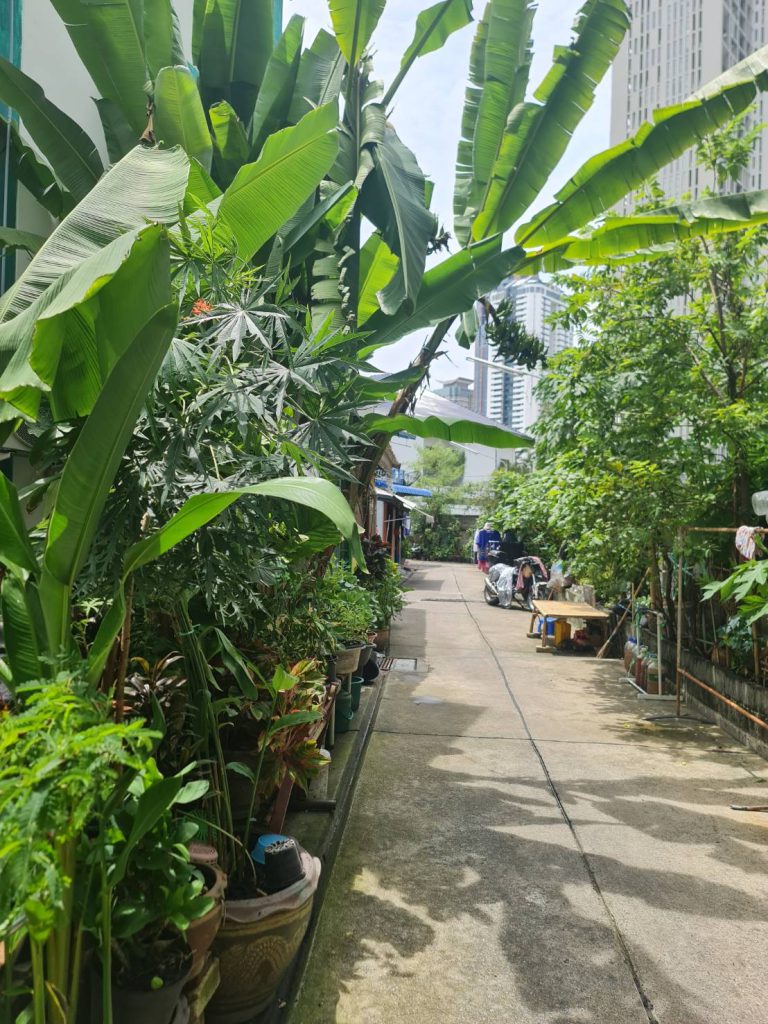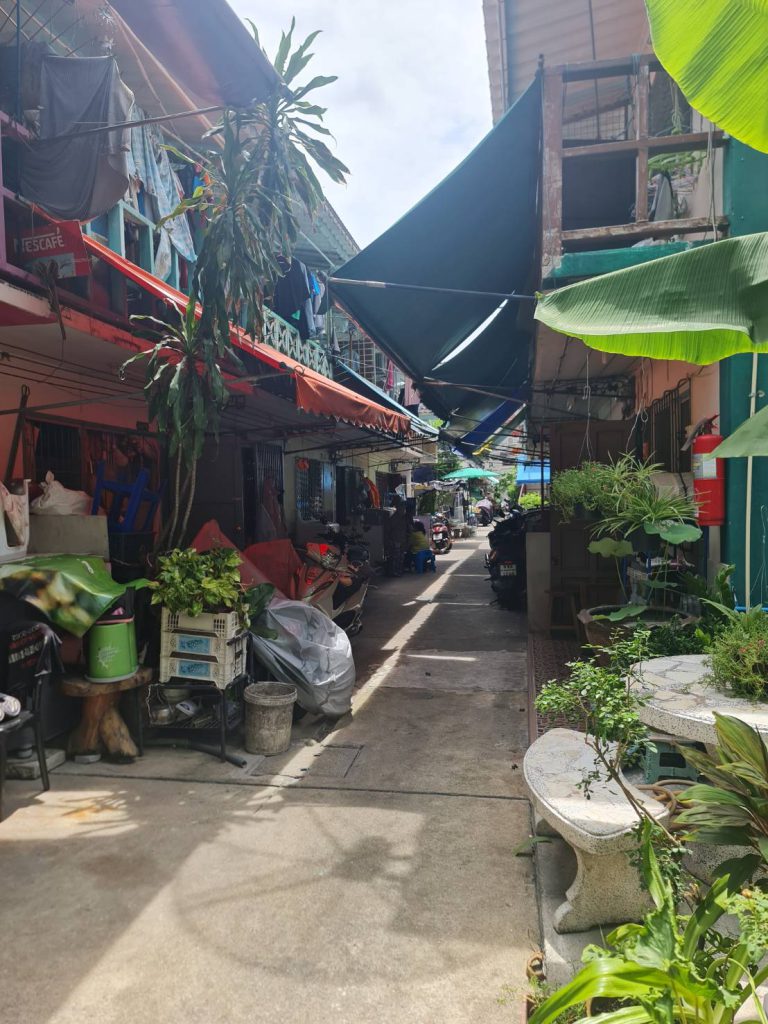Written by: Porntip Wongjom
Edited by: Siriporn Choontu
When Flames Gave Birth to New Life Opportunities
In the past, Suanplu Community was just another urban slum in the heart of Bangkok, marked by insecure living conditions. Houses were cramped together on 19 rai of state property, accommodating about 5,000 people. The environment was unsuitable for living and riddled with social problems.
But on April 23, 2004, a major fire destroyed more than 717 houses. This tragedy became the turning point that led to sustainable development and the creation of a new community—“Baan Mankong Suanplu.”
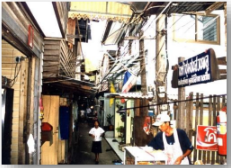
Suanplu in the Shadows of the City: Hidden Problems Beneath High-Rises
Suanplu Community, located in Sathorn District, Bangkok, was settled illegally on land owned by the Treasury Department.
- Environment: The area was formerly canals and swamps with no clear access. Residents had to request passage through Thung Mahamek Police Station. Access to electricity and water was limited and uneven.
- Social Issues: Overcrowding bred crime and illicit activities—petty theft, gambling, drug use.
- Economy: Most people lived hand-to-mouth—street vendors, construction laborers, and drivers. Income was insufficient, savings were impossible, and informal debt was rampant.
The fire of April 23, 2004 devastated more than 1,700 households in 717 houses. Government and private agencies rushed to provide temporary shelters at Bangkok Technical College, Ban Mahamek School for the Deaf, Sathorn District, Bophitpimuk, and other facilities. Some stayed with relatives, others rented small houses, while many built makeshift huts on their original plots—fearing they would not be allowed to return to the land.
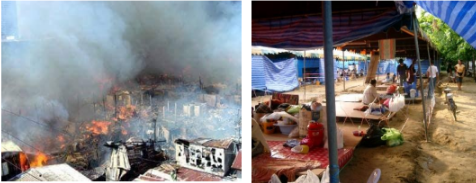
From Fire to Baan Mankong: Recovery through People’s Participation
The Cabinet later resolved to assign relevant agencies—National Housing Authority, Ministry of Social Development and Human Security, Treasury Department, Ministry of Finance, along with civil society partners such as Baan Mankong Network and Four Regions Slum Network—to find solutions.
Two options emerged:
- Baan Eua-Arthorn housing program (chosen by about 60% of residents who were less inclined to join collective processes).
- Baan Mankong housing program (chosen by 40%, who trusted community organizations and collective management).
The Baan Mankong Network and the Four Regions Slum Network held discussions with residents, building confidence in the program. Community leaders visited housing development models such as Charoenchai Nimmitmai and Bonkai Community.
A community working group was formed to survey household data and needs of 814 affected families, with support from CODI as mentor. At the same time, debris clearance began to prepare for reconstruction.
The Process Towards “Baan Mankong” and Community Management
Key steps taken after choosing the Baan Mankong approach in 2004 included:
1. Savings and Cooperatives
- A savings group was formed with 330 members.
- In 2005, the Suanplu Baan Mankong Housing Cooperative Ltd. was established to manage savings and coordinate with agencies.
- The cooperative grew to hold 15 million baht in revolving funds, allocating profits to 10 welfare funds covering land, education, utilities, and funeral costs.
2. Land Lease
The cooperative directly leased 6 rai, 2 ngan, 24 sq. wah from the Treasury Department for 30 years, at a subsidized rent of 9 baht per sq. wah per month, ensuring legal housing security.
3. Housing and Infrastructure Development
- CODI supported 19,570,500 baht for infrastructure.
- CODI housing loans of 45,261,018.83 baht were used for construction (2005–2009).
- Residents co-designed homes with community architects, tailoring layouts to household size and financial capacity. Options included 2-story, 2.5-story, 3-story houses, row houses, and flats (37–77 sq.m).
- Construction was done both by contractors and local builders.
The result: families gained legally recognized homes, secure land tenure, and houses designed to fit their lifestyles.
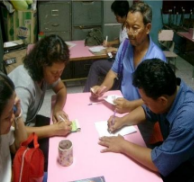
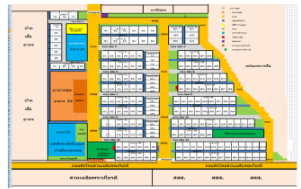
A House Beyond a House: Improving Quality of Life in Multiple Dimensions
Welfare and Savings
- Savings groups evolved into the Suanplu Baan Mankong Housing Cooperative Ltd., with 15 subgroups based on social ties.
- A Community Welfare Fund was created to support vulnerable groups—elderly, children, and disadvantaged households.
Cooperative Finance Management
- CODI loans were fully repaid.
- Cooperative revolving funds reached 15 million baht.
- Investments included:
- 5 million baht in Government Savings Bank lottery bonds (low-risk, with interest and prize opportunities).
- Loans to members for livelihood, housing repairs, and small businesses.
This balance of low-risk investments and member loans strengthened both financial security and the local economy.
A Livable Environment for All Generations
The community now includes:
- Multipurpose pavilion, learning center, playground, sports field, and early childhood center.
- Green spaces and a community vegetable garden supplying the communal kitchen.
From Community Garden to Urban Farming Network
After the fire, residents organized savings and cooperative groups that expanded into quality-of-life activities, such as the community vegetable garden.
This garden:
- Provides food security, especially vital during COVID-19, when a communal kitchen supplied meals using homegrown and donated vegetables.
- Serves as a multi-purpose urban farm—a food source, activity space, and learning hub.
- Connects with the national City Farm Network, supported by the Sustainable Agriculture Foundation (Thailand) and other partners.
Activities include crop rotation, compost-making workshops, and pest management training. The garden became a model showcased at the City Farm Festival.
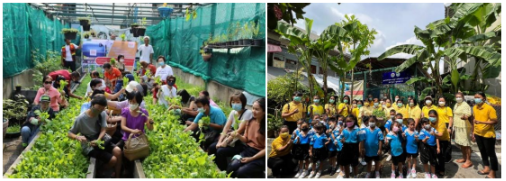
Early Childhood Development Center: Building Futures
Founded on February 24, 2008 by the Sikkha Asia Foundation and the community committee, with 10 million baht funding, plus contributions from Japanese labor groups for a multipurpose building.
The center:
- Supports holistic development—physical, emotional, social, cognitive.
- Prepares children for formal schooling.
- Relieves parents for work responsibilities.
- Meets national early childhood standards in administration, learning, and child outcomes.
Activities include food security projects (vegetable planting), community kitchen collaboration, and waste management (recycling, composting, soap from used oil).
Strengthening Household Economy
With partner support, the community developed:
- Shops, vending machines (water, laundry).
- Training for food products and herbal processing.
- Online markets and branding for community goods.
- Household vegetable gardens to cut food costs.
Health and Elderly Care
- A Community Health Center linked with the National Health Security Office (NHSO) and public health centers.
- Volunteer health workers provided regular monitoring.
- During COVID-19, a communal kitchen helped vulnerable families.
- Special care for the elderly through welfare planning, home visits, recreation, and outside agency linkages.
Suanplu as a Learning Community and Inspiration
Suanplu is now a Baan Mankong Learning Center, showcasing how communities can self-manage housing problems systematically and sustainably.
- It hosts study visits from Thailand and abroad.
- Community leaders also share experiences externally, becoming “teachers” of lived knowledge.
These exchanges inspire others and strengthen collective pride.

Partnerships and Collaborations
- CODI supported housing and food security initiatives.
- Thai Health Promotion Foundation (ThaiHealth) was pivotal in the City Farm project, providing funding, training, and linking networks.
- Other partners: government ministries, NGOs, and private donors supported communal kitchens, facilities, and activities.
Suanplu Baan Mankong: From a Small Community to a Model for Urban Transformation
Suanplu Baan Mankong is more than just a neighborhood in central Bangkok. It is a symbol of community power—people managing their own lives and future through strong networks and shared goals.
From resisting eviction and recovering from fire to becoming a national model of urban development, Suanplu has shown that “a united, resilient community that refuses to surrender” can turn insecurity into opportunity for learning and transformation.
Today, Suanplu stands proud as a living learning center, inspiring others with the lesson that security begins in the hands of the people themselves. When small efforts are woven together, they can transform not just a community—but an entire city.
